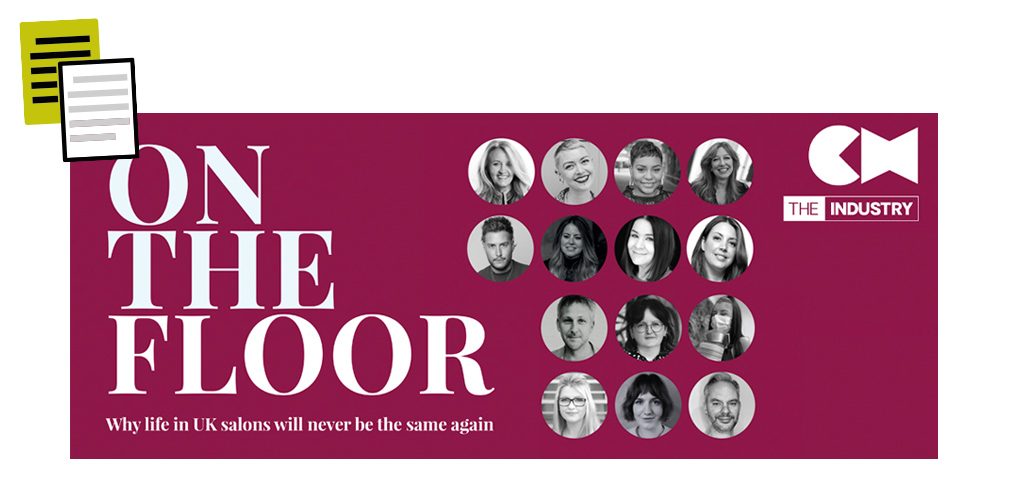
On The Floor
With more than 60 per cent of the UK salon workforce now being self-employed and the traditional mould of a job in hair seemingly broken – Creative HEAD decided to delve into why life in UK salons will never be the same again…
After an undoubtedly challenging period for UK hairdressing due to several lockdowns and changes to the world of salon work accelerated and complicated by Covid-19, it has become clear that the industry is experiencing profound changes at almost every level. With old norms no longer fit for purpose as stylists and owners search for new ways of working, it is apparent that the industry is at a major crossroads. The question is, what are the next steps for UK hairdressing?
On The Floor, a major new study produced by Creative HEAD sat down with members of the National Hair & Beauty Federation (NHBF), the Freelance Hairdressers Association, the Hair & Barber Council, Save Our Salons, The Fellowship for British Hairdressing, and readers of Creative HEAD to speak freely about the future of hairdressing. Employers, employed stylists and self-employed stylists discussed the social and economic implications they face as they tackle new ways of working. The key findings revealed everything from issues in apprenticeship schemes and a lack of quality young applicants for salon owners to the rise of opportunities for the self-employed as the stigma associated with freelancing diminishes.
KEY FINDING #1: THE SOCIAL NETWORKS
Self-employment is no longer just mobile hairdressing, and brands are wising up. Due to advances in technology, the self-employed are riding high as brands fall over themselves to work with them. A desire for more freedom, control and money as well as a frustration with salon hierarchies is prompting a new generation to cut loose from the salon – and social media has opened the floodgates.
KEY FINDING #2: IN THIS TOGETHER
Salon life offers staff and clients so much more than when stylists go it alone. There is an argument that salon life offers something unique due to the team, opportunities and stability. Stylists employed in salons – both junior and senior – are confident that salon life sets itself apart from freelancing, especially when it comes to being part of a team.
KEY FINDING #3: CASHING OUT
Boosting the bottom line is at the heart of many people’s decisions to go solo. Stylists are acutely aware of how much business they bring into the salon and when they calculate they can earn more working for themselves than by being employed this becomes a key driver into self-employment.
KEY FINDING #4: SEARCHING FOR STAFF
Salons are struggling to find the next generation of talented, passionate hairdressers. Ongoing and significant challenges around recruitment due to a lack of quality applicants of school-leaving age are causing many employers issues. Not helped by schools continuing to prioritise academic routes over apprenticeships to students, and hairdressing rarely being promoted as a viable career option.
KEY FINDING #5: APPRENTICESHIPS AREN’T WORKING
Owners and stylists alike believe the system of apprenticeships no longer functions. Currently, salons tend to avoid employing older apprentices as those aged 19 and over can only be paid at the apprenticeship rate for the first year of their apprenticeship – the following year their wage adjusts to the appropriate National Minimum Wage band for their age and this is simply unaffordable for many salons when the student is unable to generate any income for the business.
KEY FINDING #6: MONEY RULES
HMRC, compliance and VAT rules combine to make a minefield. Salon employers have never felt so challenged, with so many staff migrating into self-employment, and non-VAT paying businesses undercutting them on price.
KEY FINDING #7: FINDING THE WAY FORWARD
Do new business models offer the solution? Almost all the employers Creative HEAD spoke to had staff who had left to go self-employed and were trying to address the reasons why this would be happening. There was universal agreement that employers need to remain relevant and competitive within the industry, offering benefits to staff that aren’t necessarily available to the self-employed. Many are working on introducing more flexibility into working practices within their salon, with a view of improving their team’s work/life balance.
